George, Drew, David (picture: left to right), and Jamie operate a community and online store for active people, LiveOutThere (currently debunked). Jamie, the chief adventurer, recently summited Mt Everest for the second time and the entire team went along for the trek to Mt. Everest Base Camp. After spending a week in Hong Kong, George, Drew, and David landed in Kathmandu and began their trek. Please enjoy this (slightly more than) week-in-the-life of the team as they trek to Mt Everest Base Camp!
This post was originally published in 2010, and has since been updated for accuracy of links and content.
Day 1: Kathmandu
Our journey starts with a bang in the capital of Nepal, Kathmandu. George’s best friend Jamie is climbing Mt. Everest, and we have come along for the ride. The Maoists are protesting and the city has ground to a halt.
The wheels touch down and we strike off into the city. We step off the plane, shuffle through the airport, collect our bags, and find the curb. A throng of people crush against the chain-link fence outside the baggage claim. We see our guide, Ang Temba Sherpa, holding a “Berg Adventures” sign.
As we make our way to the hotel, protesters bang their hands against the windows of the van, and a ring of red-shirted teenagers surrounds us at one intersection. We keep our heads down and try to attract as little attention as possible. We arrive safely at the Yak & Yeti, where we meet the rest of the team.
Day 2: Lukla
The next morning we catch a flight to Lukla (the most dangerous airport in the world!), the only village with an airstrip in the lower Khumbu Valley. After a safe landing on a short runway, our first day on the trail is an easy start to a long, tough journey. We descend from 9,000 feet to the Dudhkosi river that runs through the valley and begin following the water. There are homes most of the way from Lukla to Phakding, where we stop for the night. Every available piece of land is terraced and cultivated. Big smiles and adorable children greet us as we follow the trail to Phakding. We are sure to walk to the left of the prayer flag poles and mani stones we find on the trail, in accordance with the Sherpa people’s Buddhist religious beliefs.
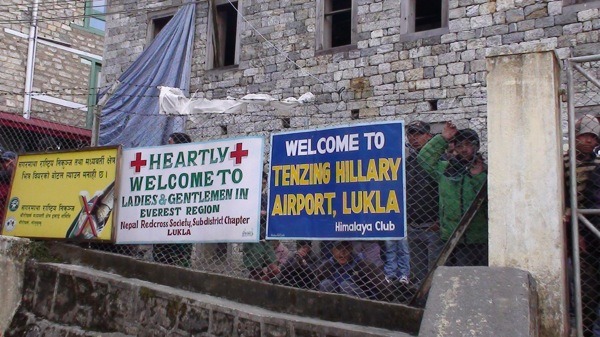
Day 3: Phakding
The village of Phakding is neatly tucked into the side of the river valley. Our lodge sits high above the water, and we arrive just in time to see our pack train being unloaded. Feeling lucky we didn’t have to carry it ourselves, we sit down for dinner with our Sherpa guides and soon-to-be-friends. After dinner, exhausted, we climb into our beds.
Day 4: Namche
Today we ascend to the market town of Namche. Following the river valley for several kilometers, we cross impressive cable bridges and stop for pictures, tea, and snacks. The climb is long and hard. Switchback after relentless switchback, we climb higher.
After two hours, we reach the town of Namche Bazaar – a cross-roads for traders, merchants, and outfitters. Perched precariously on steep terraces, Namche is colorful and different. We are now at 11,200 feet, and starting to feel the effects of altitude. After resting for one more day to acclimatize, we continue upwards and catch our first glimpse of Mt. Everest.
Day 5: Khunde & Khumjung
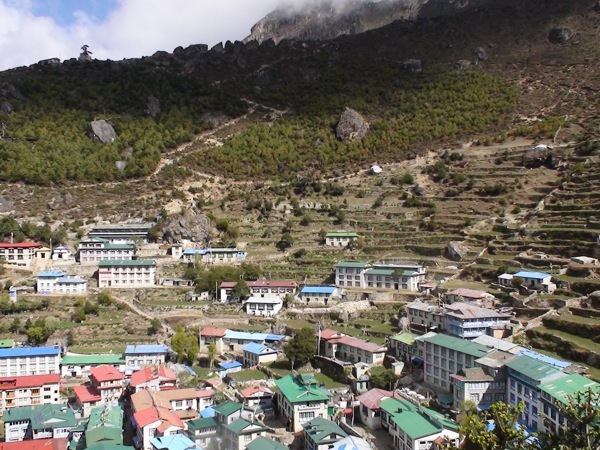
Between Namche and our next stop, the village of Khunde, we pay a visit to the Sir Edmund Hillary memorial. Constructed by the Sherpas, the memorial honors Hillary for his unforgettable impact to the lives of the people of the Khumbu Valley. Khunde and Khumjung are twin villages, set high in the Khumbu Valley, and the elevation is 12,100 feet. It is spring, and along the edge of a weathered rock wall there are baby yaks lying in the moss. I ask Nima Sherpa how old the wall is. “I don’t know”, he says, “but it was here before my father and before my father’s father, and long before that.” We spend the night in Khumjung.
Day 6: Tengboche
Today, Ang Temba Sherpa sets the pace and the experience is meditative rather than grueling. We place one foot, slowly; and another, slowly; resting at each step. At the top of the Tengboche hill, a climb of 1,500 vertical feet, we pay a visit to the largest monastery in the region. The walls are painted with Buddhist murals – life, death, war, peace, plenty, and famine, a circular story covering the four walls of this holy place. Carved mani stones chant the mantra Om Mani Padme Hum from the sides of the trail. I ask Nima Sherpa again, “How old are these stones?” and he says, “I don’t know. We don’t carve them any more. Very old.” There are thousands of them.
In the monastery we visit with an old Buddhist Lama, Lama Geshe. Lama Geshe is 76 years old and we sit with him for an hour. He talks while Ang Temba Sherpa translates. Please share this message, he asks: don’t judge others; live for today, and be kind. We are all the same. Finally, he bumps each one of our foreheads with his and smiles broadly.
From Tengboche we descend on a rock path and birches and rhododendrons bow over the trail. The steepness of the valley walls is hard to fathom. At times, mist shrouds the top of each side of the valley. Sometimes, the clouds shift and we get a glimpse of even more massive snow-capped Himalayan peaks. The scale is enormous.
Day 7: Pangboche
Tonight we will have our first view of the summit of Mt. Everest from the window of the dining room of our lodge. The summit ridge rises like a shark fin behind Nuptse. We can just make out the tiny bump that is the Hillary Step and I wish I had a pair of binoculars. We relish our last decent accommodations and prepare for a hard day tomorrow.
Day 8: Pheriche
The climb to Pheriche is tough. We are at higher altitude now – 14,000 feet. This is the elevation where most people begin to suffer. The landscape begins to change drastically. Plants disappear, and rocks and lichen take over. Above this point, the landscape is post-apocalyptic. We spend another acclimatization night here, and on the second morning, George is still so tired he has to have Nima Sherpa pack his sleeping bag.
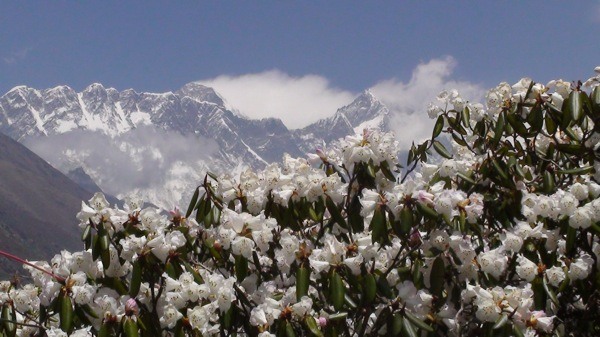
Day 9: Lobuche
Exhausted, we struggle in to Lobuche after a hard day. Passing through the Sherpa memorials in the Dugla Pass, we observe the dozens of cairns erected for people who have lost their lives in the Himalaya. Prayer flags flutter in the wind and nobody says much. We are cold and tired, and I have picked up a small tickle in the back of my throat. George begins to have bad headaches.
Day 10: Gorek Shep
Struggling up the moraine on the side of the Khumbu glacier after Lobuche, we are in a maze of endless piles of crushed rocks and gravel. Cairns mark the trail and we occasionally rise above the oppressive embankments to see more oppressive embankments. Our O2 saturation has dropped significantly. Normally 98%+ at sea level, our readings from the pulse oximeter we carry are in the mid to low 80’s. Every breath is becoming a chore, and our hearts begin to beat faster to provide our bodies with oxygen – 100+ BPM even at rest.
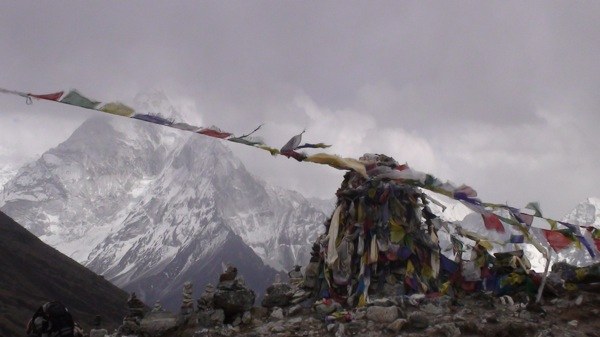
Gorek Shep literally means “dead raven”. It is not pleasant. Reminiscent of a wild western town in the middle of a Nevada desert, an old lake bed abuts the cluster of a few ramshackle buildings. We are one day away from Mt. Everest Base Camp.
Ang Temba invites us for the final climb, to Kala Patar, a hill rising 18,400 feet, it will afford us the best view of Lhotse and the top of Mt. Everest. George declines, but David and I struggle up out of our chairs and follow the tired group as we walk to the trailhead at the edge of the dry lakebed.
The climb to the top is exhausting. Every step is a tremendous effort and none of us can imagine going any higher, much less 11,000 feet higher to the 29,035 foot summit of Mt. Everest.
David and I muster the last reserves of our strength and walk down as quickly as we can. I collapse into my sleeping bag. George is already in bed, having napped during the afternoon. He still has a terrible headache that is growing worse. I’m so cold I put on my 800-fill down jacket inside of my 800-fill down sleeping bag and I can’t stop shivering.

Before dinner Ang Temba prods us out of our bags. “You have to come to eat,” he says. “You’ll feel better.” We grudgingly emerge from our cocoons and follow him to the main room of the lodge. This is the low point of our trip. My appetite is non-existent, but slowly, I force down some soup and a little bit of rice. George eats exactly two Pringles and two Ritz crackers. David sits on the other end of the table and doesn’t say a word. Leila Berg, one of the owners of our trekking company, tries to cheer us up. Seeing our misery, she opens her first-aid kit and distributes drugs like candy. Azithromycin, paracetamol, gravol and anti-histamines. I refuse the antibiotics – I figure I’m just suffering from a bad viral head cold.
The night is terrible. George lies beside me, staring vacantly. He clutches his head. I lie in my bag, shivering, unable to get warm or comfortable. I try different positions and drift out of a delirious fugue.
As the hours creep by George becomes more and more uncomfortable. In a fit of panic, he gasps, “I can’t take this anymore.” and clutches his head. He almost has tears in his eyes. I tell him to go get oxygen, and he does; shuffling slowly down the hallway to Ang Temba’s room. A few minutes later they return with an O2 tank and Ang Temba fits the mask to George’s face. We get back in bed and I drift to sleep to the sound of Darth Vader’s breathing.
Day 11: Mt. Everest Base Camp
The next morning we feel markedly better. I figure if I’ve come this far I can make it the last few hours to Everest Base Camp. The original plan was to spend two nights there, but based on the way we’re all feeling, we decide that a quick visit for lunch will be just fine. George opts out, and David and I split from the group temporarily with Nima Sherpa.
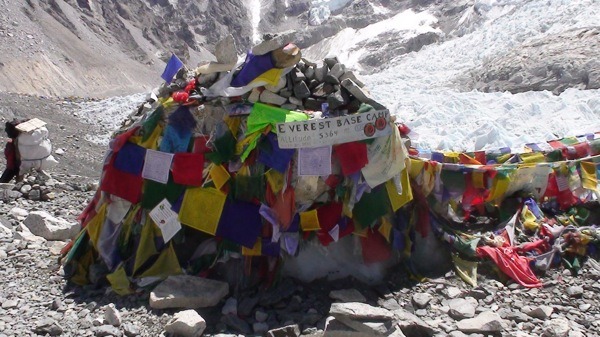
The walk along the moraine is tough, up and down on bad trail. It is frustrating and it takes 3 hours from Gorek Shep, even though we can see the tents of Base Camp most of the time. Upon arrival, we take in the surroundings with mixed feelings. It is both anti-climactic and rewarding. The reward has been in the journey, not the destination, but it is still awe-inspiring. We are at 17,300 feet and we are glad we made it. After a short visit with Wally Berg, Leila’s husband, we head back down to Pheriche.
Day 12: Descent to Pheriche
On the descent, David and I pick up our pace, striking a rhythm with our trekking poles. My stomach begins to bother me. We return to Lobuche quickly. From Lobuche we descend to the Dugla Memorial, and Nima is somewhere behind, visiting Sherpa friends. He always rejoins us, running up from behind, never out of breath and with a big smile on his face. We marvel at him. He tells us that while training for his successful 2009 Everest summit he summited 22,220 foot Mt. Lobuche 7 days in a row!
After 5 hours and 18 kilometers we reach Pheriche, where we reunite with a healthier, happier George. Later that night, we get a radio call from Wally. Jamie wants George to come back to base camp to celebrate after his summit, but after much deliberation it’s decided that Jamie will have to share his success with his friend later – George can’t go back up.
Day 13: Return to Namche
The next day we leave early in the morning for Namche. It will be another big day. I wake up with an uncomfortable pang in my stomach as my stomach issues worsen. Half an hour later I consider whether to ask Leila for some antibiotics but decide against it. As we are leaving we get another radio call, it is Jamie, at 8:40am on May 17th, standing on the summit of Mt. Everest for the second time. “I’ve climbed all of Everest,” he says. George screams into the radio, “Woohoooo!! Good work buddy! Now get down safely okay.” It is a moment that we won’t ever forget.
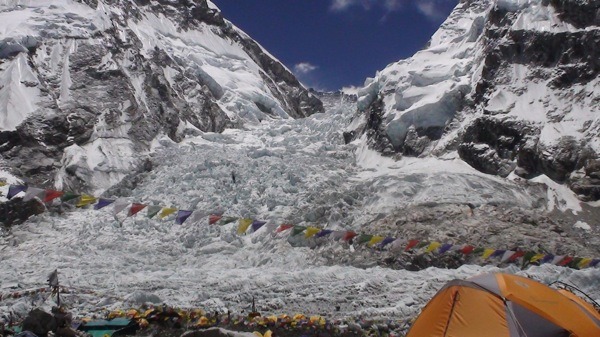
We start down to Pengboche. David and I lead the group, moving quickly like the day before. My stomach bugs me more and more, and I pull over a few times. The last section, down to Tengboche and the bottom of the river valley is a grind. The hill goes on forever, and the descent is tough. I start to feel worse and worse. I’m coughing, weak, my head is swimming and I feel nauseous. By the time we get to the bottom of the hill for lunch, I’m done. I pull out my Thermorest, lay it on the ground, and curl up. The change happened surprisingly quickly, and there is no way I can cover the remaining distance to Namche on foot. Leila gives me some Azithromycin and orders a horse.
Within a few minutes, a Sherpa arrives with a horse in full livery; a saddle and bells with a young girl to lead it. I clamber up and close my eyes as the girl leads my horse ahead of the group. After 10 minutes, I’m not sure what would be worse: the horse, or walking on my own. We traverse along a series of bays in the mountainside, each a small bowl in the hill with a corner in the distance. Around each corner I hope to see Namche, but each time, I’m disappointed. It seems to take hours. My head swims.
Finally, after two hours, we turn a corner and are back in Namche. I am incredibly relieved. Once I get to my lodge, I head immediately to the toilet, where I spend the next 12 hours. When not in the bathroom, I shiver constantly in bed and George and David come to visit me in quarantine.
Day 14 & 15: Namche
We spend the next two days recovering in Namche. By the second day, I feel better. We lounge around; the air at 11,200 feet feels great. We spend time at the internet café and David and I even go out to a bar on the final night.
Day 16: Lukla
We get up early and leave Namche for Lukla. The trail is beautiful again. Verdant vegetation grows everywhere, farms are tended, homes, livestock, and people line the trail. We’ve been gone long enough that the barley has turned green in our absence.
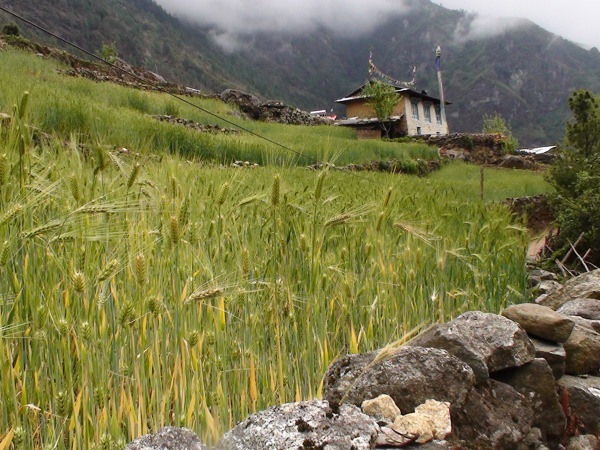
After lunch George and I get frustrated with the slow pace and break away from the group. The final half hour is hot, exhausting, and miserable. We have to climb back up 500 feet into Lukla and the stone path is steeper than we remember. Finally, we get to the gate. George is sitting at the top with a huge smile on his face. “We did it buddy!” he says, and I sit down beside him. We have hiked 120 kilometers in two weeks, ascending from 9,000 feet at Lukla, to 18,400 feet at the top of Kala Patar, and back again.
Back in Kathmandu
A few days later, we sit in the Yak & Yeti. What did we learn? We can only approximate our experiences, even to each other. Certainly no one at home will understand this trip. Certainly no reader will get the full experience. It seems a distant memory. It was hard, but we didn’t breathe too hard on the incredibly steep hills. It was easy, but we might not want to do it again. It was a contradiction. It was beautiful, it was miserable. It was an experience of a lifetime, and we are still reflecting on it. We do not regret it, and we are glad.
After returning home, the team is focused on growing their business until their next “business trip”. David wants to hunt for treasure in the jungles of South America, and George, having suffered on the trail, has actually developed a certain fondness for it. So you can be sure the team will be up to something interesting in the next year – follow them on their journey at LiveOutThere.com. If you are interested in trekking to Mt Everest Base Camp Jamie suggests you contact Berg Adventures International, as Wally and Leila do a tremendous job.


